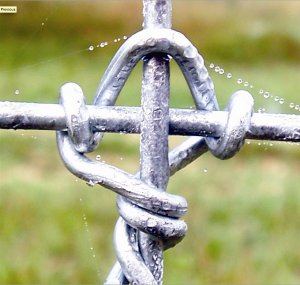How is it that flocks and herds can grow so fast? Ten ewes turned into 20 and starting with one steer we suddenly find ourselves with 15 head! Well, okay, it wasn’t that sudden, but it didn’t take that long either, with one phenomenal Jersey milker and a supply of dairy bull calves.
Now what? Now we need some permanent fence around our fields to make grazing easier and to keep the animals out of the swampy areas & sugar woods. A visit with Nick Commerci from the St Johnsbury NRCS office assured us that they could help fund some fences so we delved into the first challenge of the project – pouring over maps and areal photos and countless walks around the fields to figure out the best fence layout around buildings, determining exactly where gates and corners would go, counting posts and measuring field edges so we could order the ~12,000′ of fence that NRCS agreed to help with.

According to the manufacturer: “This electrifiable hi-tensile woven wire is more effective than other conventional fences when not electrified and extraordinarily effective when electrified. It has 7 horizontal strands, 36 inch height, and 24 inches between vertical spaces. The wire used is a 12.5 gauge, minimum 180,000 psi for superior strength. The fixed knot holds the wires firmly in place at Horizontal spacings from the bottom of 4-1/2″, 5″, 5-1/2″, 6″, 7″, 8″. Multiple Design Functions – Basically No Maintenance – 3-4 Times Stronger than Standard Farm Store Woven Wire – Requires about 1/2 the Posts needed for Standard Field Fence – Gives with Pressure but Maintains its Shape – Does not sag with Downward Pressure – Retains its tension – Class III Galvanized Coating with the addition of zinc/aluminum – Increased Longevity 3-4 times – Rust and Corrosion Resistant – Deters Predators”
What kind of fence to choose? That was the easy part! Several years ago I saw an article in David Kline’s Farming Magazine about an electrified, high-tensile woven wire. My parents have used it on their farm with great success so without hesitation, we decided to use that for a large percentage of our farm as well. This wire is really fantastic because it is easier to hang on Vermont topography than regular woven wire but it is much more effective than 5 or 7 strands of HT smooth wire.
The specs on this fence are 7-36-24, so it has seven strands of horizontal wire at a total height of 36” and verticals every 24”. We put a ground wire on the ground and hang the fence up 6”. This amount can vary with the terrain, but we try to keep it less than 9” and more than 4”. We also string a hot wire 8” above the top of the wire. So the total fence height is about 48”. Insulators must be put on each post, however we don’t insulate every strand, just 3-4 per post. On corners we slide a piece of 3/4” pvc down between the post and wire during tensioning or staple a few 3/8” fiber rods around the outside of the post before tensioning.
The fence is wired with maximum flexibility in electrification options. We can just make the top wire hot to keep cows & horses from reaching over and to provide an electricity source for electronet subdivisions. This gives the animals a chance to eat down grass right along/under the fence. Or we can electrify the whole fence whenever needed to keep them from rubbing on it, to train livestock and/or predators. Because it is woven wire it provides a visible physical barrier for the animals.
Because there is so much less wire in this fence than most woven wire, it is less expensive so it fits into an NRCS budget more easily. Given that it holds animals more effectively than smooth wire, is easier to install and less expensive than woven wire, it is a clear choice for a large variety of fence applications.
In the interest of full disclosure, I’ll tell you that I’m not affiliated with the company in any way. I think that there are folks in the Northeast who could really benefit from knowing about and taking advantage of this fantastic fence. We’re installing over 7,000′ of it this year. My folks have had theirs for almost 5 years and they love it for sheep, goats, cows and horses.
 Now we’re on to the biggest challenge of any fencing project – installing it. We’ve got about 1200′ up, only ~6,000′ to go!
Now we’re on to the biggest challenge of any fencing project – installing it. We’ve got about 1200′ up, only ~6,000′ to go!






